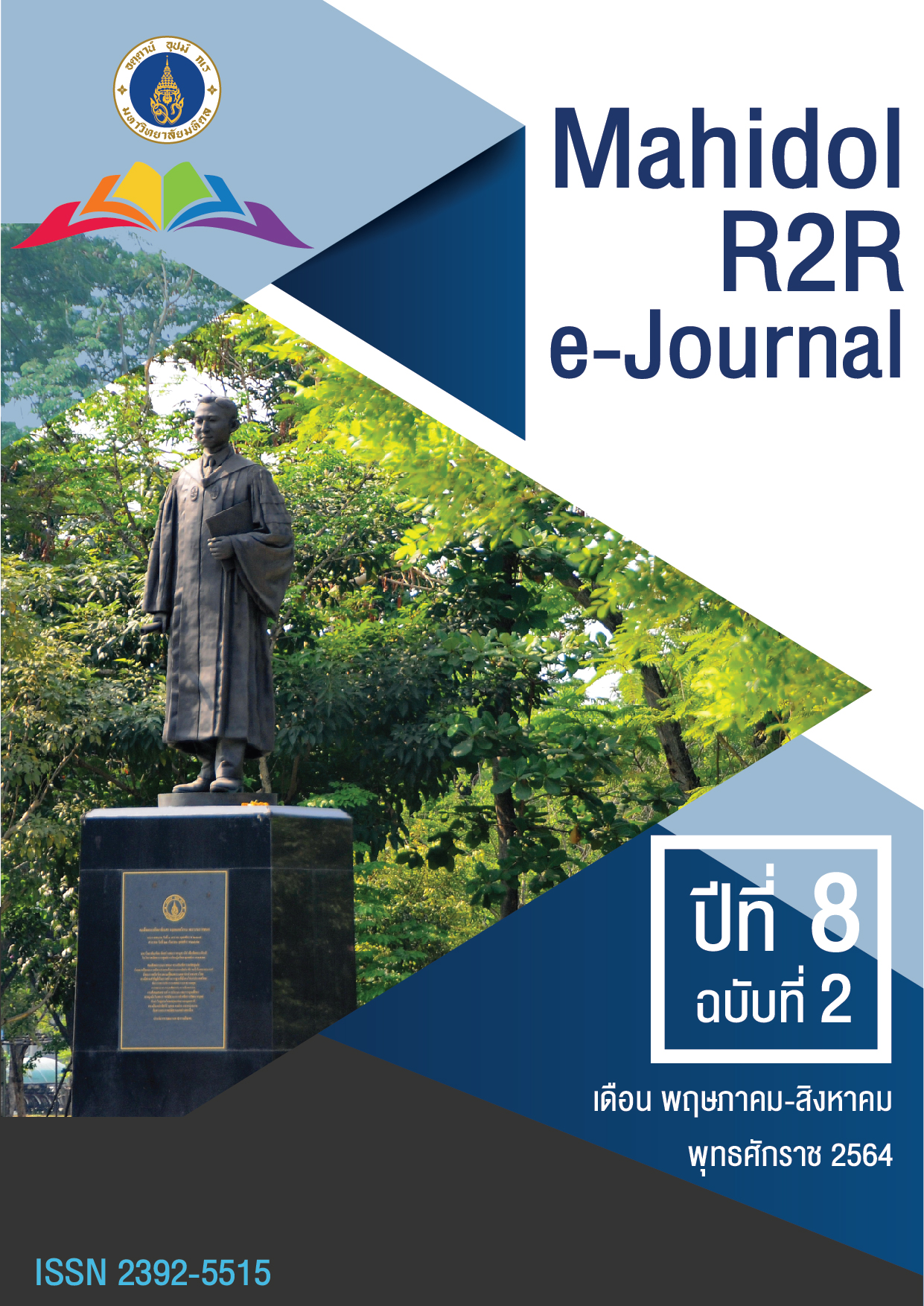ผลของโปรแกรมการฝึกการหายใจอย่างช้าต่อการลดความดันโลหิต ในผู้ป่วยโรคความดันโลหิตสูงระดับที่ 1
DOI:
https://doi.org/10.14456/jmu.2021.23คำสำคัญ:
โรคความดันโลหิตสูง, โปรแกรมการฝึกการหายใจช้าบทคัดย่อ
การศึกษาในครั้งนี้มีวัตถุประสงค์เพื่อเปรียบเทียบผลของโปรแกรมการฝึกการหายใจอย่างช้าต่อความดันโลหิต ชีพจร และอัตราการหายใจในผู้ป่วยโรคความดันโลหิตสูงแบบไม่ทราบสาเหตุ กลุ่มตัวอย่างเป็นผู้ป่วยเพศชายและหญิงจำนวน 40 รายอายุตั้งแต่ 20 ปีขึ้นไปที่เป็นโรคความดันโลหิตสูงแบบไม่ทราบสาเหตุระดับที่ 1 ที่ยังไม่ได้รับยา ผู้ป่วยถูกแบ่งเป็น 2 กลุ่ม ผู้ป่วยในกลุ่มทดลองได้รับความรู้เกี่ยวกับโรคความดันโลหิตสูงและโปรแกรมการฝึกหายใจอย่างช้า ผู้ป่วยในกลุ่มควบคุมได้รับเพียงความรู้เกี่ยวกับโรคความดันโลหิตสูงเท่านั้น วิเคราะห์ผลการศึกษาโดยใช้สถิติแบบพรรณนา ผลการศึกษาพบว่า ค่าเฉลี่ยระดับความดันซิสโทลิก ระดับความดันไดแอสโทลิก ชีพจร และอัตราการหายใจของผู้ป่วยในความดันโลหิตสูงชนิดไม่ทราบสาเหตุระดับที่ 1 ภายหลังได้รับการฝึกโปรแกรมการหายใจอย่างช้าลดลงอย่างมีนัยสำคัญทางสถิติที่ 0.001 ผลการทดลองดังกล่าวอาจเป็นแนวทางในการส่งเสริมและป้องกันในการดูแลรักษาผู้ป่วยโรคความดันโลหิตสูงต่อไป
เอกสารอ้างอิง
Porkovic V., Huxley,R.,wu, Y., Prabnakaran,D.,& Macmahon,S. (2007). The burden of bloodpressure related disease : A negloted priority for global. Hypertension, 50(6), 991-997.
d, A., Kader, B.,& Berlowitz,D.(2010). The epidemiology and management of severe hypertension. J Hum Hypertens,24(1), 9-18.
สำนักรายงานสถิติแห่งประเทศไทย. (2558). สถานการณ์ระบาดโรคหลอดเลือดสมอง.
Siriyanaluk, T., Ponyasupan,U.,&Srikaew,M. (2011). Complementary core practice among patient with hypertension. Priness of Naradhiwas University Journal, 3(1),61-72.
Suwannee Jarunggitaree. Cardiopulmonary physical therapy. 2nd end. Living trans media company LTD,Bangkok, 1998.
สมาคมโรคความดันโลหิตสูงแห่งประเทศไทย. (2562). แนวทางการรักษาโรคความดันโลหิตสูงในเวชปฏิบัติทั่วไป.
Mourya, M., Mahajan, A.S., Singh,N.P.,&Jain,A.k. (2009). Effect of slow and fast breathing exercise on autonomic functions in patient with essential hypertension. Journal of Alternative and complement Medicine,15(7), 711-717.
Pal, G. K., Velkumary, S.,& Madanmohan. (2004). Effect of short-term practice of breathing exercise on autonomic functions in normal human volunteers. The Indian journal of medical research, 120(2), 115-121.
RajeevMohankaushik,Reshmakaushik Sukhdev,Krishanmahajan Vemreddirjesh. (2006).Effects of mental relaxation and slow breathing in essential hypertension. Department of Holistic Medicine, Himalayan Institute of Medical Sciences, Dehradun 248140,Uttaranchal,India. Available online 10 January.
William J. Elliott, Joseph L. Izzo, Jr,& William B White. (2004). Graded Blood Pressure Reduction in Hypertensive Outpatients Associated with Use of a Device to Assist with Slow Breathing. The journal clinical hypertension.Vol.VI No.X October 2004.
วาริน โฆศิริมงคล, นรลักษณ์ เอื้อกิจ, ปชาณัฏฐ์ ตันติโกสุม. (2561). ผลของโปรแกรมการฝึกหายใจอย่างช้าต่อระดับความดันโลหิตของผู้ป่วยความดันโลหิตสูงชนิดไม่ทราบสาเหตุ. กรุงเทพฯ: โรงพยาบาลตำรวจ.
William j .Elliott,MD,Phd; Joseph L.Izzo,Jr,MD; Willam B. White,MD; Douglas R. Rosing,MD; et.al. (2004). Graded Blood Pressure Reduction in Hypertension in Hypertensive Outpatients Associated With Use of a Device to Assist with Slow Breathing. The journal of clinical hypertension.Vol.VI No.X October 2004.
ดาวน์โหลด
เผยแพร่แล้ว
ฉบับ
ประเภทบทความ
สัญญาอนุญาต




